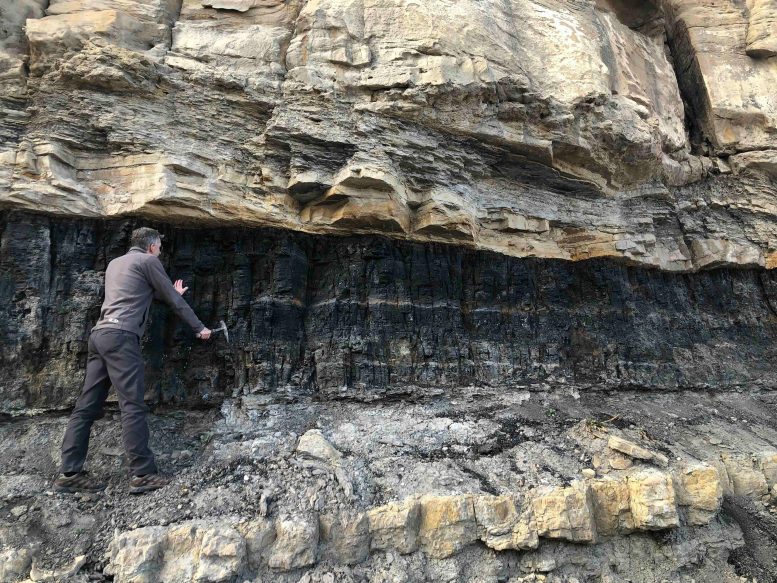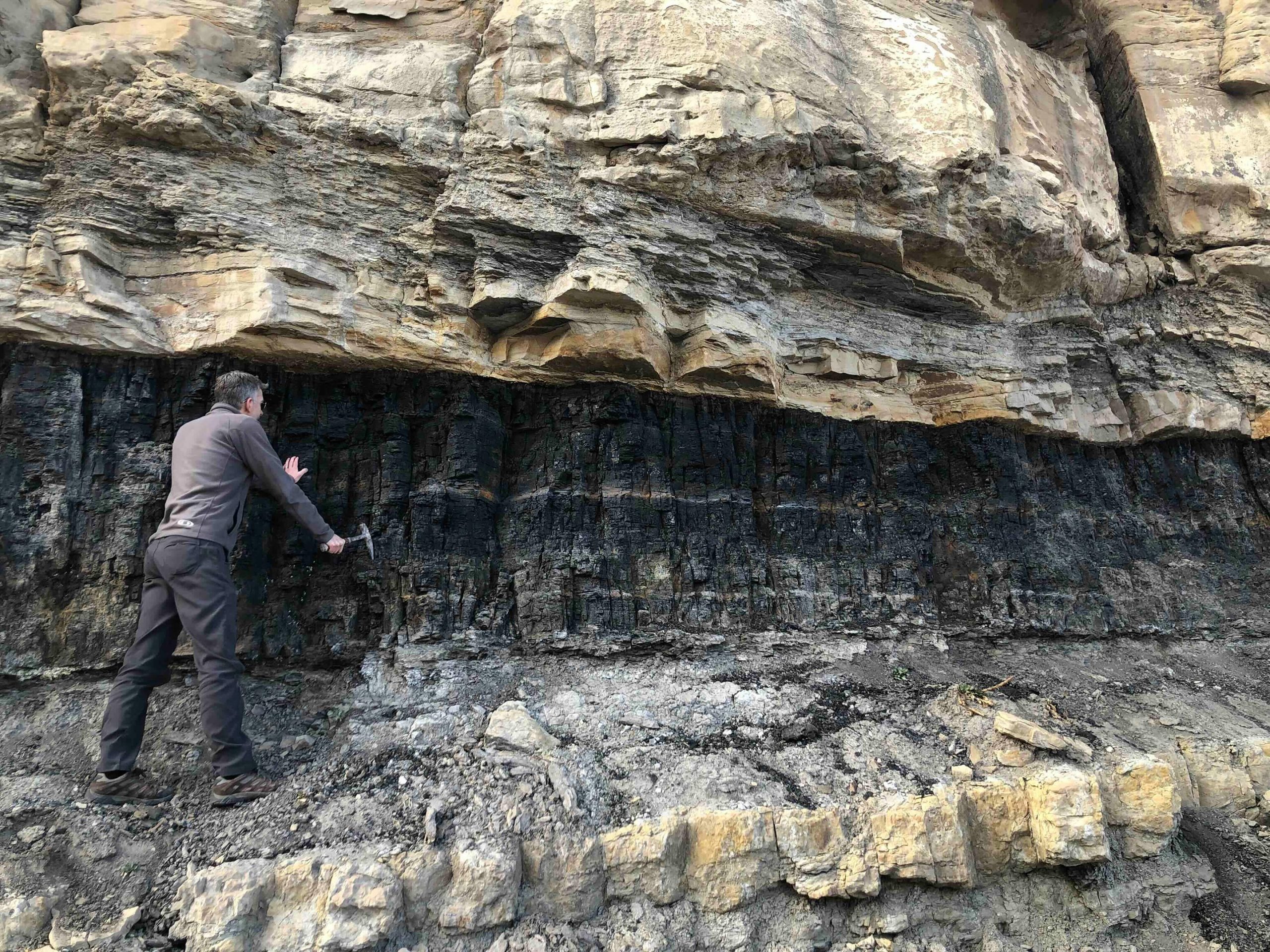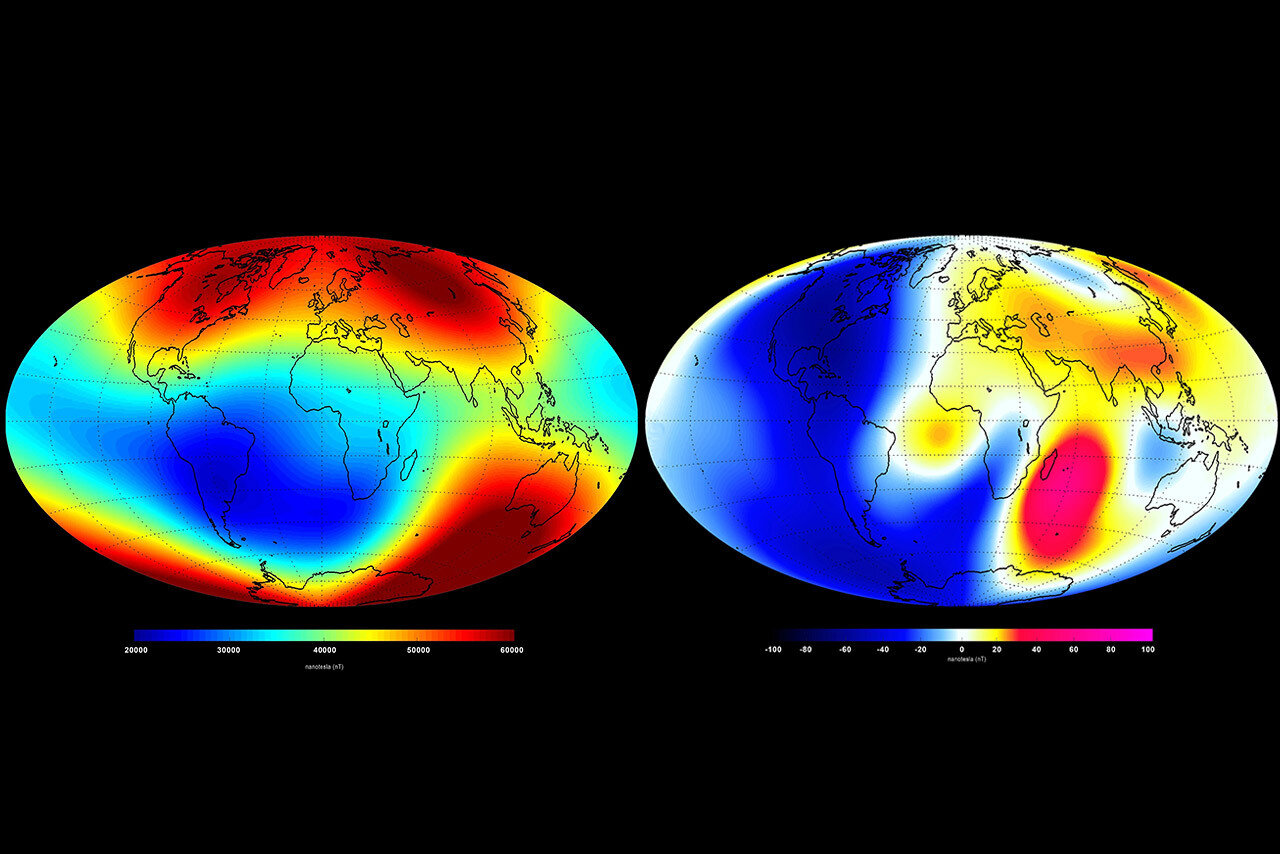From black gold to green energy: Mining rare earths alongside coal

Michael Vanden Berg, a geologist with the Utah Geological Survey, examines a coal seam near the old Star Point mine in Utah. Credit: Lauren Birgenheier, University of Utah
New research documents elevated levels of these metals, needed for the energy transition, above and below coal seams in Utah and Colorado.
Deposits of identified critical minerals needed to transition the world’s energy systems away from fossil fuels may, ironically enough, be co-located with deposits of coal that was mined to produce the fossil fuel that contributes most to climate change.
Now research led by the University of Utah has documented elevated concentrations of a key subset of critical minerals, known as rare earth elements, or REEs, in active mines lining the Uinta Coal Belt in Colorado and Utah.
According to study co-author Lauren Birgenheier, associate professor of geology and geophysics, the findings open up the possibility that these mines could see a secondary source of resources in the form of metals used in renewable energy and many other high-tech applications.
“The model is that if you’re already moving stones, could you move a little more resource stones towards the energy transition?” Birgenheier said. “In these areas, we find that the rare earth elements are concentrated in the fine-grained shale units, the mud shales that are above and below the coal seams.”

University of Utah geologist Lauren Birgenheier inspects samples on a pile of coal processing waste. Credit: Michael Vanden Berg, Utah Geological Survey
Searching for alternative sources of rare earths
This research was conducted in collaboration with the Utah Geological Survey and the Colorado Geological Survey as part of the Department of Energy-funded Carbon Ore, Rare Earth and Critical Minerals, or CORE-CM, project. The new findings will form the basis of a grant application for an additional $9.4 million in federal funding to continue the research.
While these metals are key to U.S. manufacturing, especially in high-tech, they are largely sourced overseas.
“When we talk about them as ‘critical minerals,’ a lot of the criticality has to do with supply chain and processing,” said Michael Free, professor of metallurgical engineering and principal investigator of the DOE grant. “This project is designed to look at some alternative non-conventional domestic sources for these materials.”
The study, led by the U, was published last month in the journal Frontiers in Earth Science. Team members included graduate students Haley Coe, the lead author, and Diego Fernandez, a research professor who runs the lab that tested the samples.
What are rare earth elements?
Despite the nickname, rare earth elements (REEs) are not rare in the Earth’s crust, but they are rarely found in concentrations high enough to make their extraction economic. According to the Bipartisan Policy Center, nearly 90% of the global supply is processed in China.
These metallic elements include 15 in the lanthanide series, as well as scandium (Sc) and yttrium (Y), all found in the third column of the periodic table.
These elements are usually found in their oxide forms. Because they exist in such low concentrations, they are difficult to separate from ores and from each other.
Rare earths have special properties that make them essential components in materials associated with high-tech applications.
“It’s really rooted in the types of compounds you can make with these rare elements or these critical minerals that make them attractive and more effective,” said Michael Free, a professor of metallurgical engineering at the University of Utah. “If you look at the more rare elements, neodymium (Nd), praseodymium (Pr) and dysprosium (Dy), they can be combined with other elements to make high-performance magnets.”
Many lanthanide compounds are used in glass and catalysts, as well as magnets, superconductors, phosphors, lasers, and luminescent materials. Rare earths are also found in everyday technology such as televisions and smartphone screens, medical devices, auto and fluid catalytic converters. These elements also require carbon-neutral energy technologies, including wind turbines, solar panels, electric vehicles, rechargeable batteries and energy-efficient lighting.
“With turbine blades, such as in a windmill for power generation, you want to use higher-powered magnets to make them more efficient. It basically helps us in some of these energy transitions. It’s about energy efficiency, it’s about energy density for storage,” Free said. “There are a lot of strategic things with some of these elements that are critical, that are used in high-end electronic devices and satellite technology and defense applications. These kinds of elements work much better than the more common elements that you’re familiar with.”
According to the US Geological Survey, the US consumes an average of 8,300 metric tons of rare earth oxides per year. The Mountain Pass mine in California’s Mojave Desert is the nation’s largest producer of rare earth elements, but most of its output is sent overseas for processing.
“Here, the offer is not very established in some cases. It was introduced to some extent, but then it was sent overseas because we didn’t want to source here. We didn’t want to open new mines here,” Free said. “So we’re vulnerable to a lot of these cutting edge and clean energy technologies that we’re trying to get more into.
The link between coal and rare earth deposits has been well documented elsewhere, but little data has previously been analyzed for the once-bustling coalfields of Utah and Colorado, which have fallen on hard times as domestic demand for coal has shrunk. But amid a longer-term decline, the remaining active coal mines in Utah and Colorado report that they can’t mine fast enough in recent years to meet demand and high coal prices.
“The goal of this phase one project was to gather more data to try to understand if this was something worth pursuing in the West,” said study co-author Michael Vanden Berg, program manager for energy and minerals at the Utah Geological Survey. “Is there an enrichment of rare earth elements in these rocks that could provide some kind of by-product or added value for the coal industry?”
The study focused on a coal-producing region stretching from Utah’s Wasatch Plateau east through the Book Cliffs deep into Colorado. The researchers analyzed 3,500 samples from 10 mines, four mine waste piles, seven stratigraphically complete cores and even some coal ash piles near power plants.
The study included the active Skyline, Gentry, Emery, and Sufco mines in Utah, the recently mined Dugout and Lila Canyon mines in Book Cliffs, and the historic Star Point and Beaver Creek No. 8 mines. The Colorado mines studied were Deserado and West Elk.
Analysis of rock samples by the thousands
“Coal itself is not enriched with rare earth elements,” Vanden Berg said. “It’s not a byproduct of coal mining, but for a company mining a coal seam, could it take up several feet of floor space at the same time? Could they take a few feet of ceiling? Could there be potential? That’s the direction the data has taken us.”
In collecting samples, the team worked directly with mine operators and examined coal seam outcrops and processing waste piles. In some cases, they analyzed drill cores, both archived and recently drilled at the mines. The team entered mines in Utah to collect rock samples from the underground ramps that connect the coal seams.
The researchers deployed two different methods to record the levels of REEs present, expressed in parts per million or ppm, in the samples. One was a hand-held device for rapid readings in the field, the other used inductively coupled plasma mass spectrometry, or ICP-MS, in a campus lab overseen by Fernandez.
“Usually we use this portable X-ray fluorescence device, which is an analysis gun that we hold on the rock for two minutes, and it only gives us five or six of the 17 rare earth elements,” Birgenheier said. If the samples showed concentrations higher than 200 ppm, they performed a more complete analysis using mass spectrometry equipment on campus.
The Department of Energy has set 300 ppm as the minimum concentration for rare earth mining to be potentially economically viable. However, in the study, the researchers considered concentrations higher than 200 ppm to be “REE-enriched.”
The study found the highest occurrence of these concentrations in the siltstone and shale coal seams, while the sandstone and coal themselves were mostly free of rare earths.
The team has analyzed 11,000 samples so far, far more than were used in the published study. Next steps include determining how much rare earth ore is present, which will likely be done with colleagues from the University of Wyoming and the New Mexico Institute of Mining and Technology.
“We still have results that are in progress and documents that are coming out soon,” Birgenheier said. “We are now writing a proposal for phase two. We cannot yet estimate the volume of resources because we do not have this data. This next phase will make us answer, ‘How do we actually calculate the volume of rare earths in these deposits?'”
How did the elements get there?
The study did not identify the geological process that enriched the formations adjacent to the coal, but Birgenheier has several theories. Many of Utah’s coal-bearing formations were deposited during the Chalky a period that ended 66 million years ago, when the western US was volcanically active.
“There are two models. One may be that volcanic ash brought rare earths into the ancient peatlands,” she said. “The second is the evidence that the terrestrial organic material in the peatland actually takes up the heavy rare earths.”
Then, with time, heat, and burial, the peatlands enriched with rare earths became the coal deposits of Utah and Colorado.
“We think the rare earths were in the coal and migrated into the adjacent silts or siltstones above and below the coal,” Birgenheier explained, “probably through a process called diagenesis, basically any fluid movement that occurs in a rock after it’s been deposited. “
Reference: “Rare Earth Element Enrichment in Coal and Coal-Contiguous Strata of the Uinta Region, Utah, and Colorado” by Haley H. Coe, Lauren P. Birgenheier, Diego P. Fernandez, Ryan D. Gall, Michael D. Vanden Berg, and Andrew Giebel, April 10, 2024, Frontiers in Earth Science.
DOI: 10.3389/feart.2024.1381152














Post Comment